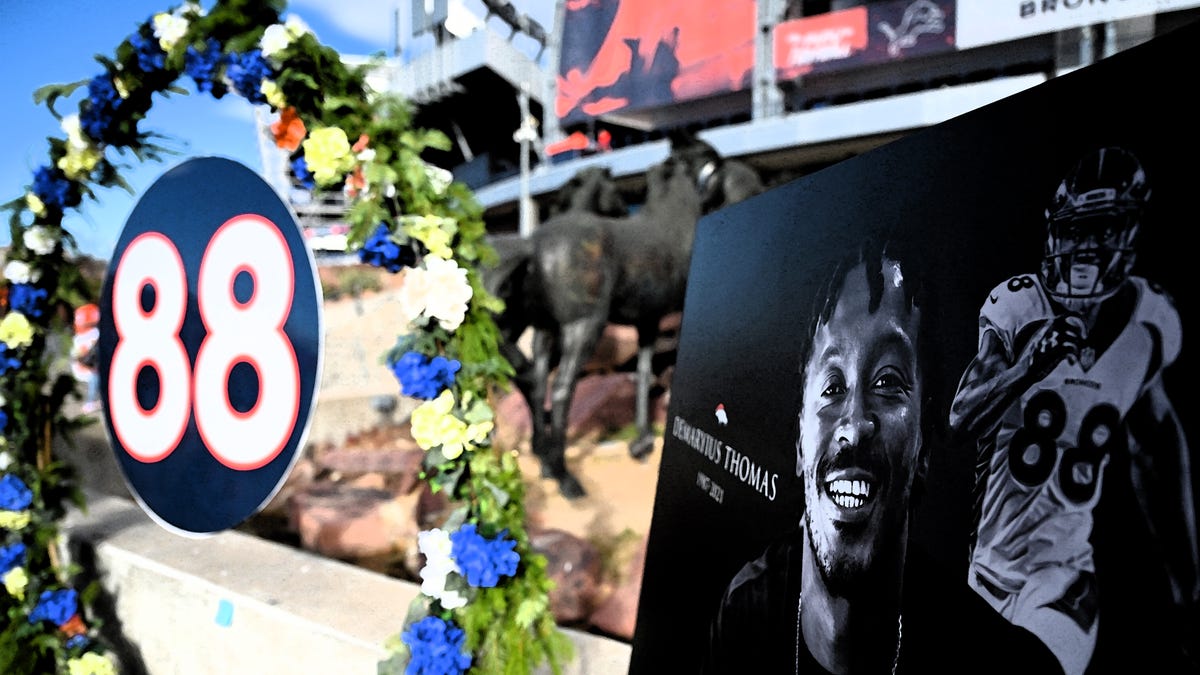Demaryius Thomas’ CTE case a stark reminder that all football players, regardless of position, are at risk

No one is shielded from CTE exposure once they first put on the pads and a football helmet.
Demaryius Thomas, whose CTE was confirmed postmortem, only strengthens that tragic reality. The degenerative brain disease connected with repeated blows to the head existing in the late wide receiver’s brain was verified by doctors at Boston University earlier this week. That team of specialists was diagnosing Thomas’ case through the Concussion Legacy Foundation.
Alarm bells rang between connections of football and CTE several years ago. Thomas’ addition to the group of those affected isn’t shocking but comes as a reminder: The disease is ruthless to all who play the sport. The notion that linemen are solely affected because of constant jostling with defenders is wrong. Quarterbacks taking sacks from 300-pound behemoths or running backs averaging 25 carries per game being the extreme examples of affliction is also incorrect.
Just playing the sport puts you at risk.
“I’m so tired of talking to the parents and family members, sometimes children, of these players who are found to have CTE, whose lives have been cut short, really in their most promising years by this disease that could be prevented,” said Ann McKee, the director of BU’s CTE center in a recent interview with Deadspin. “[Thomas’] death wasn’t directly caused by CTE, but let’s face it, CTE played a role in his death. I have the frustration of wondering what it is going to take for the NFL to actually take on this head injury seriously.”
G/O Media may get a commission

FREE
Audible Premium Plus 3-Month Free Trial
Listen up
The Audible Premium Plus experience for Amazon Prime users includes unlimited listening to the Premium Catalog, plus (see what they do there?) one credit per month for any title of their choice.
The exact profile of a CTE patient is a football player. Actually, in a less broad sense, it’s any athlete with continual skull trauma. Cases have also been confirmed in soccer, hockey and professional wrestling. The high-profile nature of CTE existing within Thomas’ brain only underscores the high-wire act of football. FBS football is the NCAA’s greatest show, evidenced by how conferences trotted their athletes onto the gridiron during the era of the coronavirus pandemic where 100 percent of athletes were unvaccinated, risks to COVID-19 be damned. Every fall homecoming game is attached to a weekend football extravaganza. The largest alumni event in the history of my alma mater, Towson, was the school’s lone appearance in the FCS championship game, where it got trounced by North Dakota State. The event was held in Frisco, Texas, nearly 1,400 miles from the Baltimore area. And that didn’t stop the interest to travel.
The NFL is by far the most popular sports league in America. Those well-paid athletes are on display during a trio of Thanksgiving games every year. Baseball is done a few weeks before and the NBA and NHL stand idly by. Two of the four major broadcast networks, FOX and CBS, donate all of Sunday to previewing and showing NFL games. NBC has the Sunday night slot, while ESPN, part of the ABC family, finishes out the week with Monday Night Football. And then there’s the Thursday Night games that will be hosted by Amazon. And what community doesn’t use high school football as a cornerstone event?
“[The NFL has] focused on concussions and concussion management. That’s the tip of the iceberg,” added McKee. “Although concussions are part of the problem, the much more prominent problem is the subconcussive hits that don’t cause symptoms [and these hits] occur on nearly every play of the game for nearly every player. It’s those repetitive hits, hundreds, thousands of hits, that occur over a year and then over decades because these players like Demaryius played for decades.”
The impact of one case, like Thomas’, shifting football’s landscape is impossible. He’s not the first standout player to have CTE, or unconfirmed symptoms while living. And the longtime Denver Bronco, who died at 33 last December, won’t be the last. Thomas’ family thought that the seizures the Georgia Tech alumnus battled since 2019 led to his passing, but the Fulton County, Georgia coroner’s office has yet to release an official cause of death.
McKee points to major changes in tackle football as a big preventative measure for CTE, including more passing plays where old-school trench warfare is a less-used tactic, bigger fields and fewer players on the field at one time could have positive effects. Quicker and more tangible differences could be seen from reducing practice time, limited contact in practice and shortening games and the playing season. Maybe most importantly, the NFL committing resources to end-of-season testing to scan players for early signs of CTE would be useful, McKee believes. She added the NFL’s theory comes off as: “If we don’t look for it, we won’t find it.”
Thomas’ playing style as a physical, crisp route-runner actually lends itself against taking extra hits to the head and developing CTE. His 6-foot-3, 225-pound frame does, too. The NFL has put several guidelines in place over the years to limit the helmet-to-helmet contact “defenseless” players face with the evolution of targeting. It’s commonly known it was too late to save the likes of Junior Seau, who committed suicide a decade ago at 43 and had CTE. Thomas, however, might’ve been a pro a little too early to be weaned out from that statistic.
The same fate awaited Vincent Jackson, who died in February 2021 at 38 and had CTE after a dozen years in the NFL. Other wide receivers and tight ends to have symptoms of the disease (Antwaan Randle El and Frank Wycheck) or have it confirmed postmortem (Dwight Clark, Chris Henry, Frank Gifford).
Hearing Thomas’ diagnosis made me think about whether all NFL players take that risk to sign lucrative contracts. No one is making them play football, but it is a skill they’ve spent countless hours perfecting at the sacrifice of time with family and working on other possible professional crafts. Hearing of the doom involved with concussions and CTE isn’t exactly the ramifications necessary to give up lifelong dreams. I guess it’s an assumed risk with any physical activity, with football being more injury-prone than most.
It’s a hard sell because technology has advanced to keep players as safe as possible with padding all over their bodies. Most of the barbarism of the NFL is part of the game. Every play for an offensive lineman is essentially a shoving match and you’ll be out of a job if you don’t win a majority of them. Yet, most football players don’t have a specialized position until high school and could be 15 or 16 when that occurs. That’s several years after Pop Warner starts. McKee and the team at BU have found early signs of CTE as young as 17.
“If you could raise the starting age of playing, the first thing that would reduce is the number of playing years. You start later, you’re going to play fewer years,” McKee added. “Research has shown that the hits you get playing youth football are just as great, if not greater in some instances, than high school and college-level football, and certainly pro football.
“This isn’t just a disease of elite athletes who play at the professional level, many [of] who get compensated for millions of dollars. This is a disease that affects youth athletes, amateur athletes, high school athletes, college athletes. Anyone who gets enough head impacts can develop this disease.”
For all the latest Sports News Click Here

